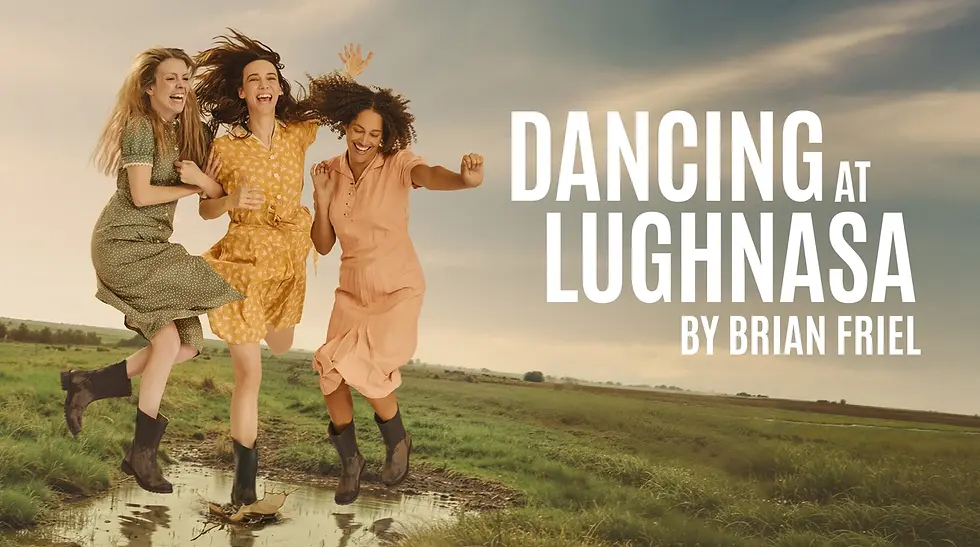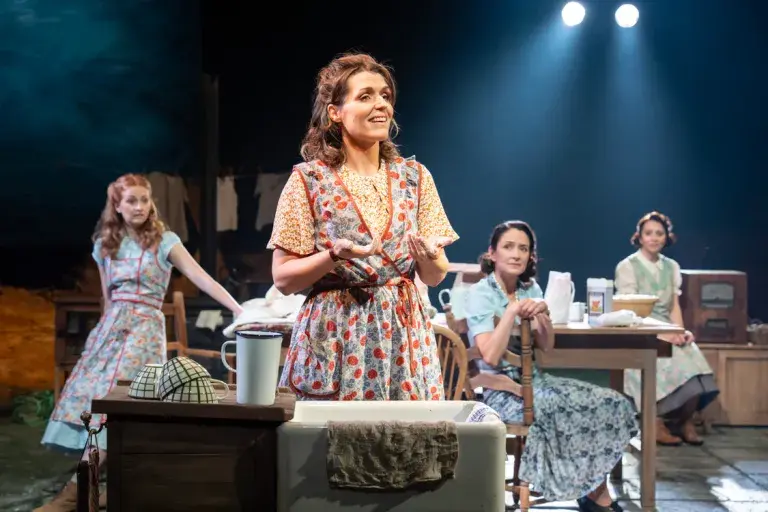REVIEW - DANCING AT LUGHNASA | ROYAL EXCHANGE THEATRE, MANCHESTER | 22/10/2025
- Sarah Monaghan
- Oct 23
- 3 min read


Dancing at Lughnasa – A Tender, Timeless Dance Through Memory at The Royal Exchange Theatre
Brian Friel’s Dancing at Lughnasa is a masterwork of Irish theatre — a poignant, semi-autobiographical “memory play” that explores family, faith, love, and loss through the hazy recollections of one summer in 1936 Donegal. Now directed by Elizabeth Newman, this production marks a triumphant Manchester debut following its acclaimed run at Sheffield Theatres, where Newman began her new chapter as Artistic Director. With its transfer to The Royal Exchange Theatre, Dancing at Lughnasa adapts beautifully to the in-the-round staging, enveloping the audience in the heart of the Mundy family home.

Told through the adult Michael, the play recalls a summer when his seven-year-old self lived with his mother, Christina, and four aunts — Kate, Maggie, Agnes, and Rose — in rural Ireland. The sisters’ lives are simple but strained: making gloves for a pittance, tending to the house, and clinging to laughter and music amid hardship. Their fragile world begins to shift when their brother, Father Jack, returns home from years as a missionary in Uganda, changed by the experience and questioning the faith he once served.
Amidst visits from Gerry, the charming but unreliable father of Christina’s child, and the ever-present hum of their unreliable radio, Friel’s story delicately weaves memory, nostalgia, and the ache of longing. Newman’s direction keeps the play grounded in its humanity — a piece that explores duty, repression, freedom, and the dance between what we remember and what we wish had been.

Francis O’Connor’s set design is rich with texture and symbolism. The worn family table, the washing line, and the scattered fragments of home all evoke a sense of faded memory — tangible yet dreamlike. The set cleverly uses the round to create different areas of life within the Mundy home. The world feels immersive, a living memory shaped before our eyes.
Pippa Murphy’s music, from lilting Irish melodies to the jaunty strains of 1930s radio, captures both the joy and melancholy of the piece. When Anything Goes bursts through the static of the wireless, the audience can’t help but feel the pulse of life stirring in the room. The lighting, soft and golden, adds warmth and nostalgia, while Sundeep Saini’s choreography shines most brightly in the sisters’ wild, euphoric dance — a visceral outpouring of emotion that encapsulates everything the play stands for: freedom, joy, frustration, and release.

The cast delivers an ensemble performance full of depth and authenticity. Martha Dunlea’s Christina is gentle and hopeful, balancing youthful optimism with the weariness of a woman who has known disappointment. Natalie Radmall-Quirke gives a commanding performance as Kate — strong, devout, and complex, fiercely guarding her family’s reputation while wrestling with her own fears.
Siobhán O’Kelly lights up the stage as Maggie, bringing much-needed humour and heart; her warmth and wit make her the emotional centre of the piece. Laura Pyper as Agnes and Rachel O’Connell as Rose share a tender sisterly bond, each layered with vulnerability and quiet strength.
Kwaku Fortune’s Michael provides the thread that ties everything together, moving seamlessly between narration and memory. Marcus Rutherford charms as the well-meaning but unreliable Gerry, while Frank Laverty’s Father Jack offers a quietly powerful portrayal of a man lost between two worlds.

Dancing at Lughnasa at The Royal Exchange Theatre is an evocative and heartfelt exploration of memory, faith, and family. Elizabeth Newman’s direction honours Brian Friel’s lyrical script while breathing new energy into its themes of love and loss. Though occasionally slow-paced, the production’s emotional truth and ensemble chemistry make it deeply moving and profoundly human.
Dancing at Lughnasa is an emotionally rich and beautifully acted production that stays with you long after the final moment — a heartfelt reminder that while memories may fade, the feeling of family endures.
Dancing at Lughnasa is a tender, nostalgic, and deeply human piece that dances its way into your heart.
Dancing at Lughnasa is at The Royal Exchange Theatre Manchester until Saturday 8th November 2025. Tickets are available for purchase through the link provided below.
Photo Credit - Johan Persson
*Our tickets for this show were kindly gifted in exchange for an honest review




Comments